
Prepared by Ian Smith
Created December 1997, updated 21st June 2020
The Inside Staircase Standard LTs: LT 151-740, 742-950 (total 799) 3/1LT9/1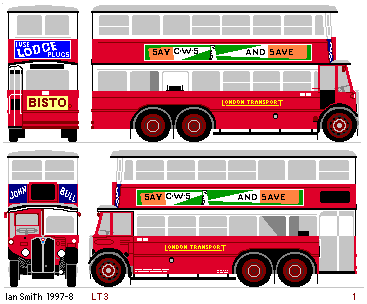 The LT3s were ordered as replacements for the S class when it became
apparent that the CCs were not going to fulfill this role.
They had AEC Renown chassis and inside staircase bodies based on the
principles adopted for the ST class:
a full-width loading platform and a straight staircase.
This did limit seating capacity to 56, however,
compared with 60 on the open-staircase LT2s.
They had windscreens and the larger type of front display case.
For some reason, probably to do with overall length limits,
the bay spacing became a uniform 35.75", compared with the 36" of the LT2s.
This complicated spares keeping,
and helped result in the segregation of the types by garage.
The LT3s were ordered as replacements for the S class when it became
apparent that the CCs were not going to fulfill this role.
They had AEC Renown chassis and inside staircase bodies based on the
principles adopted for the ST class:
a full-width loading platform and a straight staircase.
This did limit seating capacity to 56, however,
compared with 60 on the open-staircase LT2s.
They had windscreens and the larger type of front display case.
For some reason, probably to do with overall length limits,
the bay spacing became a uniform 35.75", compared with the 36" of the LT2s.
This complicated spares keeping,
and helped result in the segregation of the types by garage.
The first 360 chassis were ordered for service in 1931. Not all the bodies were built by Chiswick: Chiswick built 110 (including 10 spares); Park Royal 90, Strachans 80 and Short Bros 80. They entered service in 1931. There were the usual experimental buses and batches within the order, of course. One of the Chiswick bodies was built with the upper deck curved inwards, and a rear dome, perhaps as a prototype for the LT5 type to follow. It received the unique LT4 code. A larger variant group had AEC-Acro diesel engines: LT 191-199 were coded 4LT and kept these bodies because of various modifications to do with the transmission. They operated as a group, going first to Harrow Weald (HD), then, with modified AEC-Ricardo engines in 1932 from Hanwell (HW). In 1935 they moved to Mortlake (M). LT 439/448 were fitted with fluid flywheels and Daimler/Wilson gearboxes. Again, modifications to the bodies were needed, and these (LT3/2) stayed with petrol-engined chassis with preselector gearboxes throughout their existence. Mostly this was at Plumstead garage, where such LTs were placed together. LT165 in the LT Museum, 1998Another 450 LTs (LT 501-950) were ordered (with 463 Chiswick bodies) during 1931. Twenty of them were to be fitted with diesel engines and 20 with Daimler transmissions. Most of them were received a body design based on the LT3 but with a tumblehome at the top and a domed roof (but not as much as on the solitary LT4) They also had improved destination blinds. LT5 bodies had a large box built into the cab roof, with provision for a board placed above that (with external lamp). These lamps and boards were not allowable during the war-years, and were left unused, although the lamp housings were not removed.
In 1934 there was a programme of replacing petrol engines with oil engines,
and 169 LT3s/5s were converted.
Another 24 were converted in order to give petrol engines to the LTC coaches in 1937.
All the conversions of this group received chassis code 12LT,
with the body codes being altered at the same time:
2LT3, 2LT5 and 2LT5/1 becoming 12LT3/1, 12LT5/6 and 12LT5/5.
The remainder with crash boxes were converted in 1939-40, codes this time being 1/12LT3/3, 1/12LT5/8 and 1/12LT5/7.
The LT3s and LT5s in serviceThe first deliveries in 1931 were LT3s, which went in January to Mortlake (M), Merton (AL), Barking (BK) Nunhead (AH), Elmers End (ED) and Tottenham (AR). Some of the new buses to Nunhead displaced LT2s to Leyton. Likewise the 22 preselector-fitted LTs that went to Plumstead displaced LT2s to Leyton.
The LT5s began to appear during the Nunhead deliveries, and went to Muswell Hill (MH), Hammersmith (R), Shepherds Bush (S), Dalston (D) Chalk Farm (CF) Harrow Weald (HD) and Upton Park (U). The LT5/1s went mainly to Upton Park, and thus received that garage's distinguishing feature: a serial number on the rear roof dome, to assist in the fuelling process there.
The War and afterThe LTs were major players in keeping London moving during the Second World War. Together with the STLs they were the major crowd-shifters. They did suffer both the direct and indirect ravages of the war. A large number were destroyed in Elmers End garage by a "doodle-bug", with even more wrecked enough to require a major body rebuild. The supply of spare bodies, built for the float to keep the required number of bodies and chassis in overhaul at any one time, was used up. Even one chassis was put together from spares to "resurrect" a destroyed bus. On the other hand, one LT was wrecked twice!But even during the war there were new LT routes, as traffic patterns shifted. One notable one (for me) was the 126, a replacement for the single-deck "scooter" 254 route. After the war Chiswick Works eventually returned to repair work on buses instead of military vehicles, and the Underground train facility at Aldenham, never-used for its intended purpose but used to build bombers during the war, was prepared for use as a bus overhaul works. It started with body repairs during 1948. The repair facilities at Reigate and Elmers End were wound down as Chiswick came back on stream. LTs began to receive body repairs, mainly at Chiswick. But a few were sent to outside body builders such as Mann Egerton in Norwich and Marshall's in Cambridge for a body rebuild. The quality of available wood was still so bad that refurbished bodies did not last long. Some LTs were sent away twice! So desperate were London Transport in 1948 to keep every bus running that there was a rolling programme of body rebuilds, even for these seventeen year olds. Some went in to Chiswick Works and received extra body strapping to keep them intact for another week, or month, or year. Some were sent on to Marshall's in Cambridge for more extensive work, that would keep them going for a few months more. The odd one or two were returned by Marshall's as basket-cases: not feasible to repair. But many more fell prey to the roving Men from the Ministry, who could arrive any time and stick a prohibition order on buses they deemed unroadworthy. A one-way trip to Chiswick (perhaps via storage at Bull Yard, Peckham or Ferry Lane, Walthamstow - or elsewhere) led to the scrapyard. Until December 1948 buses were dismantled at Chiswick, useful parts being recycled, but from then on they were sent to Cox & Danks (Feltham) for the bodies to be scrapped. The chassis returned to Chiswick for dismantling. On the bright side, London was the reluctant host to the 1948 Olympics. A Special Events fleet was formed of buses, including LTs, that were too flimsy for the ardours of everyday use but were reckoned OK for the occasional outing. They dealt with other events too, such as Derby Day. The last double-deck LTs were replaced by the end of 1949, swept away by the rising tide of RTs, ready for the new decade.
|
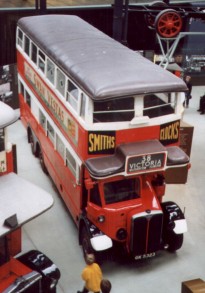
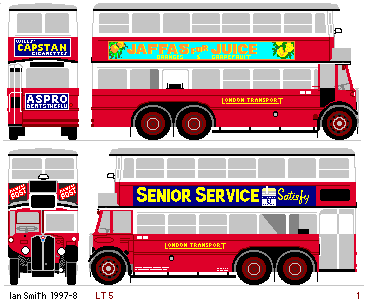
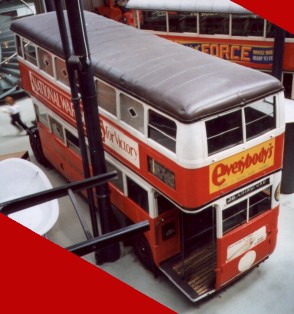
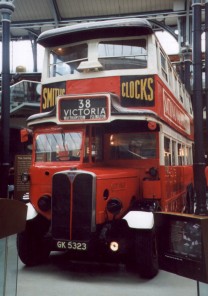
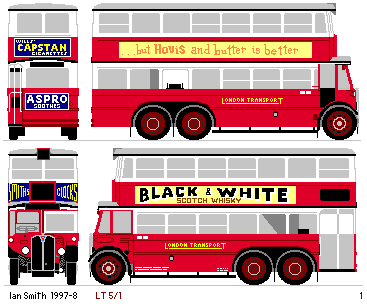 The 103 LT5/1 bodies went a stage further, with a three piece front display:
a destination line built into the cab roof, a large via-points display panel on the body front,
and a roof-mounted number box.
The 103 LT5/1 bodies went a stage further, with a three piece front display:
a destination line built into the cab roof, a large via-points display panel on the body front,
and a roof-mounted number box.
 inside stair LT histories
inside stair LT histories Ian's Bus Stop
Ian's Bus Stop LT index.
LT index. Part2: CCs.
Part2: CCs. Insiders.
Insiders.